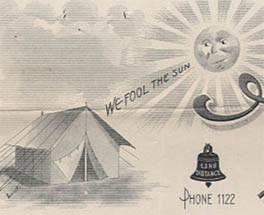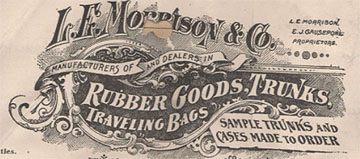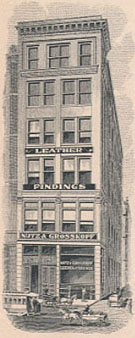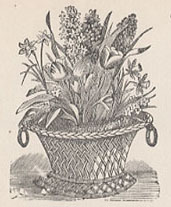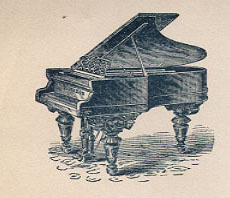Specialty Shops
Bertermann Floral Co. | Louis Gibson | Haueisen and Hartman Furniture Co.
Holloweg and Reese | Hurty Frances Pharmacy | Indianapolis Tent and Awning
L. E. Morrison | Nutz and Grosskopf | P. A. Pahud, Florist
Pearson's Music House | Daniel Stewart Company
Bertermann Floral Co. was known as Bertermann Brothers in 1883. As the name implies, the owners were two brothers, John and William Berterman. Both men were born in Prussia and moved to the United States in the 1870s.
They opened their first salesroom at 74 East Washington Street and their greenhouse at the corner of Liberty and New York Street. Later they moved to 241 Massachusetts Ave and 226 North Delaware. In their salesroom they displayed a variety of cut flowers for any type of arrangement whether for a funeral, wedding, or to brighten up a home. They also carried other items, such as dried flowers and baskets, that they used for decorating homes.
The three greenhouses had plants, flowers, and shrubs. The houses also provided a place for rare, exotic and native flowering plants to propagate. Throughout the history of the flower shop the Berterman brothers and their descendants saw a change in the use of flowers. For instance, the popularity of the carnation grew tremendously, and was often used in funeral bouquets. Furthermore, boys did not buy flowers for their girls as often. . . "the bashful swain seldom today stops in the flowershop and buys a bouquet for his lady, as he did back in the 'horse and buggy days." Bertermann Floral Co. served people like James Whitcomb Riley, Benjamin Harrison, Thomas Riley Marshall, and Booth Tarkington. According to the Indianapolis Star, Berterman's had a national reputation for floral designs because of their use of color combinations.
- Manufacturing and Mercantile Resources of Indianapolis, Indiana, 1883.
- Indianapolis Star, September 11, 1938 p. 5 c 2.
Louis H. Gibson was the son of David Gibson. Together they were in the milling business. Louis Gibson also designed hospitals for the insane with his partner Edwin H. Ketcham in Logansport, Richmond, and Evansville. The Gibson Mill was sold in 1883.
- Indiana Biography Series, v. 17.
In 1893 W. C. Haueisen and Charles L. Hartman opened a furniture store at 167 East Washington Street. Their shop included three connecting stores and a basement. The business was both wholesale and retail. They housed a variety of choice furniture from parlor and dinning room furniture to carpet and window treatments. They also carried children's carriages, boys' wagons, tricycles, and other toys. The store reached customers with in a fifty mile radius around Indianapolis. Both Haueisen and Harman were natives of Indianapolis.
- Indianapolis of Today. Indianapolis: Consolidated Illustrating Co., 1896.
The china industry grew tremendously in Indiana during the 1870s and 1880s. Louis Hollweg and Charles E. Reese met increased demand with the china shop they opened in 1867, named after themselves. Their annual sales were small in the beginning, averaging about $40,000.
However, by 1883 they had grown into four large storerooms, had 40 employees, and marketed their wares throughout Indiana, Ohio, and Illinois. Their salesmen made $25,000 in salary and expenses each year. Hollweg and Reese became one of the largest and most extensive china houses in Indiana with annual sales of $400,000. They were direct importers of china, queenware, and glass. They handled only the best stock from the famous European potteries. They also carried a full line of American manufactured white and decorated wares, American glassware, lamps of every description in glass, porcelain, pottery, plain and decorated lamp goods, supplies, novelties, and ornaments. In 1888 Hollweg became the sole owner after the death of his partner.
- Manufacturing and Mercantile Resources of Indianapolis, Indiana, 1883.
Dr. John N. Hurty was born on February 21, 1852 in Lebanon, Ohio. He attended school in Illinois. He earned his M.D. from the Indiana Medical College, which eventually became part of Indiana University. The degree of doctor of pharmacy (pro merito) was conferred upon Hurty in 1883 by Purdue University where he founded their School of Pharmacy in 1881 and served as its dean. Hurty came to Indianapolis in the 1880s as a pharmacist. He opened a drug store of his own on Ohio and Pennsylvania Streets. It was later known as the Hurty Frances Pharmacy.
Hurty was secretary of the state board of health and health commissioner for twenty-six years and was recognized as a pioneer in the health and sanitation movement. He was reappointed every four years by both Democratic and Republican governors and wrote Indiana's first pure food law. He served as president of the American Public Health Association, and was a member of the American Medical Association and the American Association for Advancement of Science.
- Indiana Biography Series, v. 2 .
Indianapolis Tent and Awning Company was established in 1892 at 447-449 East Washington Street. They had a variety of tents. They also sold wagon covers, umbrellas, a variety of chairs, flags, oiled clothing, and window, door and porch awnings. They advertised that their fair and square dealing, complied with low prices and honest goods, were the reasons for their growth and success. They also claimed their showroom was managed by a man who was up to date in the latest in the tent business.
|
It was L. E. Morrison's conviction that citizens of every town, like Indianapolis, needed protection from the elements. To encourage this, Morrison sold them with rain coats, rubber boots and shoes. In 1877 he purchased his stock of merchandise in Boston, where he had received his training and experience at the American Rubber Company, and founded his own rubber company in Indianapolis at age 23.
Morrison first established his business on the edge of the shopping district at the Bates House, on the corner of Illinois and Washington Street--known today as Claypool Courts. His rent was $60.00 a month. He could have rented a space where the L.S. Ayres store was eventually built for $100.00 a month, however, he thought he would save some money at Bates House. He soon discovered he needed to be closer to the center of town. In 1897 he moved to 36 West Washington Street. He was there for 27 years until he moved to 27 West Washington street. In 1925 he opened a branch on 18 North Pennsylvania Street.
In 1890 he began to add leather goods to his shop--it soon became the shop's specialty. At the turn of the century he perceived a change occurring in buying patterns. Customers were beginning to demand more luxury items then practical items. For instance, travel became more common. Consequently, the need for luggage and trunks increased. To accommodate this need Morrison stocked his store with an assortment of leather goods, luggage, and trunks. Sometime in the 1920s he discontinued his line of rubber items. Future generations carried on the business, which in1955 was still going strong.
- Indianapolis Star, December 28, 1952, S 6 p 5 c 4.
- Indianapolis Star, January 16, 1955, p. 20.
In 1892 Peter Nutz and Adam Grosskopf became the proprietors of a leather shop. Nutz & Grosskopf were the successors of J. K. Sharpe Jr., who had in turn taken over the business begun by his father in 1845. Nutz & Grosskopf manufactured boot and shoe uppers, and traded in leather and shoe store supplies. Nutz and Grosskopf were both from Germany. Grosskopf eventually became sole owner of the shop. He retired in 1932, at which point family members operated the store.
|
Swiss-born, P. A. Pahud established Pahud Floral Company in 1889. He located the business at 3403 Boulevard. Much of his work was sent to the Crown Hill Cemetery. He was one of the first men interested in the area around the cemetery, and helped to develop the surrounding land. After his retirement in 1922, his children ran the business.
|
Daniel Stewart Company, 42-50 South Meridian Street, was established in 1840 by Daniel Stewart as a wholesale drug store. It was the exclusive wholesaler and manufacturer of the "Old Gibralter Brand" of fluid extracts, and was widely known as "Old Gibralter Drug House". One of the products, "Old Gibralter Witch Hazel Jelly", was suppose to cure skin eruptions, pimples, chapped hands, and aid in clearing other skin problems.
Daniel Stewart Company also carried other items such as elixirs, perfumes, and a variety of pharmaceutical preparations. Furthermore, they carried the largest stock of polished plate and window glass in the state. They also dealt in beveled plate, leaded cut and window glass. A large building behind the main store housed large quantities of glass. After Daniel Stewart's death in 1892, Mr. and Mrs. John N. Carey and Mr. and Mrs. William Scott, associates who had been with the company for quite some time, shared ownership of the business.
- Indianapolis of Today. Indianapolis: Consolidated Illustrating Co., 1896.
- Hayman's Handbook, 1897.






